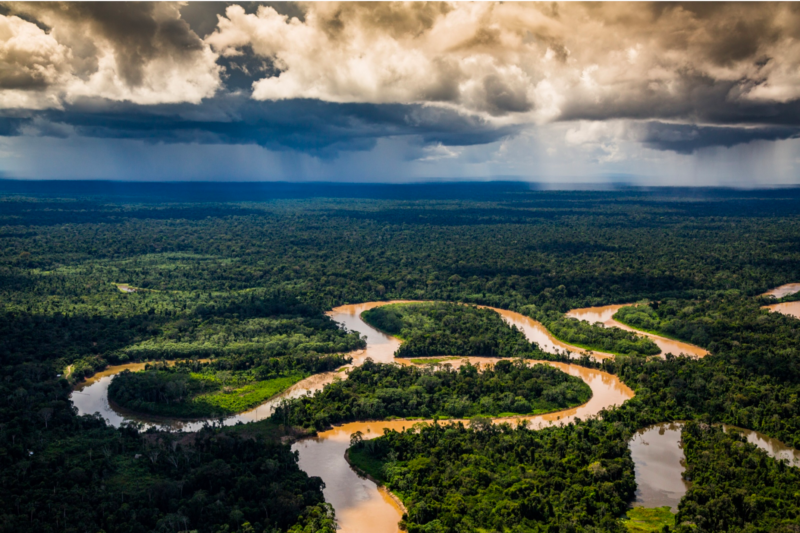
What can U.S. farmers teach scientists about reforesting the Peruvian Amazon?
An aerial image shows shallow mining ponds where a forest used to stand in the region of Madre de Dios, Peru. During gold mining, the soil is churned up, creating turbid water ponds. (Photo by Jason Houston)
If you fly over the region of Madre de Dios in the Eastern Peruvian Amazon, you will notice an endless expanse of lush forest and winding rivers interrupted by an unexpected sight: long, dirt-brown deforested areas filled with hundreds of water pools in varying shades of green and blue. These scars cut through the tropical forest and are the result of small-scale gold mining, a multibillion-dollar industry that has emerged in the last few decades and already caused around 250,000 acres of deforestation in the Amazon.
A coalition of U.S. and Peruvian institutions is working to reforest the areas devastated by the mining. They’re using as a model the Cooperative Extension System, a framework that has applied scientific research to improve U.S. agricultural efficiency for over a century.
“The Peruvian government wanted a solution,” said Wake Forest University professor Miles Silman in a Nov. 10 talk as part of the Council for Advancement of Science Writing’s New Horizons in Science briefing at the ScienceWriters2024 conference in Raleigh, N.C.

Silman’s relationship with the Peruvian Amazon started in the early 1990s. As an ecologist studying tree biodiversity, Silman frequently visited the region for fieldwork. His study area was as close to untouched forest as you could get.
But in the mid-2000s, something changed. The 2008 global financial crisis caused the price of gold to soar and created a gold rush in the Peruvian Amazon at a scale similar to the California gold rush of the late 19th century. Almost overnight, hundreds of small-scale mines appeared in the region and makeshift worker towns sprang up out of nowhere, causing widespread deforestation.
“It was really just jarring to watch as these lands got chewed up,” Silman said in his talk.
Taking a leaf from the USDA’s playbook
Silman and his Peruvian colleagues wanted to help the Amazonian communities affected the sudden mining boom, but they weren’t quite sure how. The answer came during a conversation Silman had with a colleague at Wake Forest, who told him, “The most effective model for social change in the U.S. [is] the Agricultural Cooperative Extension agencies,” Silman recalls.
The Cooperative Extension System, established in 1914, created a partnership between land-grant universities and the U.S. Department of Agriculture (USDA) to address the needs of rural communities across the United States. The system funds scientists to interact with local rural communities, understand the issues they face, and do research in federally funded universities to address those issues. The solutions devised from this research are then offered back to the communities through the USDA. As Silman puts it, “You assume the risks, create the technologies, and then you let people choose what’s most appropriate.”
Inspired by this model, Silman and his colleagues in Peru created an organization called the Center for Amazonian Scientific Innovation (CINCIA). Since 2016, CINCIA has used the approach of the Cooperative Extension to address the main environmental issues created by gold mining in the Madre de Dios region.
Silman and his colleagues followed the USDA’s blueprint in developing CINCIA: They established headquarters in Madre de Dios and collaborations with the local government as well as Peruvian universities, aiming to bridge the gap between communities and the scientific research needed to address the environmental effects of mining. The first issue CINCIA decided to tackle was reforestation.
Picking out the trees in the forest
When Silman and his colleagues started working on reforesting areas affected by mining, they realized that restoring tree biodiversity was important to the local landowners. But there was a problem. The Amazonian rainforest is Earth’s most biodiverse hotspot, containing over 10,000 species of trees. In such a varied ecosystem, how do you choose which trees to plant? As Silman explained, the answer was in the Amazon itself.
“Down there, the rivers all meander,” Silman said in his talk. “They eat away forests on one side and leave sandy new soil on the other, which is then naturally reforested. So we went in and looked at those species and said, you know, these look pretty well adapted. Can we use those?”

Using a list of around 70 native Amazonian trees created from this research, CINCIA has established 42 hectares of experimental reforested areas in collaboration with the landowners and local government agencies. “It worked remarkably well,” Silman said.
This is the largest reforestation experiment for mined lands in the Americas. The method has since been adopted by the Peruvian National Park Service and Forest Service.
CINCIA is currently applying this same logic to tackle other issues in the Madre de Dios region, such as environmental contamination caused by the gold-mining process. Moving forward, Silman wants to extend this framework to other countries affected by gold mining. “We treated this project as a hypothesis about development,” Silman said. “Does the Cooperative Extension work in communities outside the U.S.?”
To Silman, the answer is a resounding yes.